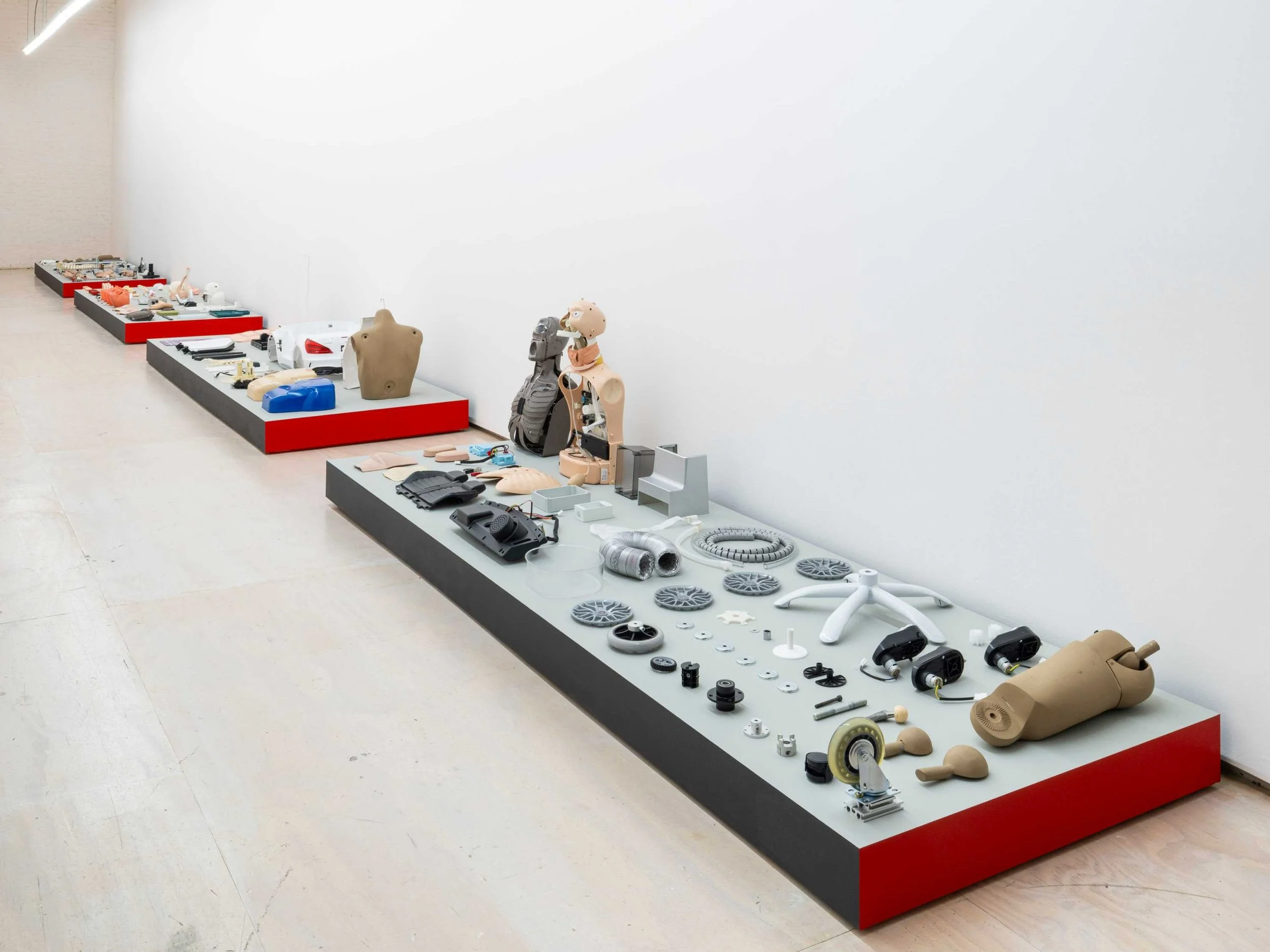The Gatherers at MoMA PS1: Few Notes on our Consumption Habits
Installation view of The Gatherers, MoMA PS1, April 24–October 6, 2025. Photo courtesy of Kris Graves and MoMA PS1.
Author: Nina Chkareuli
Among the many excellent museum surveys produced this year in New York, ‘The Gatherers’ at MoMA PS1 flashed out the defining characteristics of our time. If we think about it, any society or civilization is defined by how we gather, what is processed, and how we dispose of the waste. These three elements underscore our cultural, societal, moral, and even psychological paradigms. Looked through this lens, The Gatherers curated by Ruba Katrib has this ambition fulfilled by bringing together fourteen international artists, all born between the 1970s and 1990s.
Karimah Ashadu (British-born Nigerian, b. 1985)
Tolia Astakhishvili (Georgian, b. 1974, with Dylan Peirce and Maka Sanadze)
Miho Dohi (Japanese, b. 1974)
Andro Eradze (Georgian, b. 1993)
He Xiangyu (Chinese, b. 1986)
Samuel Hindolo (American, b. 1990)
Geumhyung Jeong (Korean, b. 1980)
Klara Liden (Swedish, b. 1979)
Jean Katambayi Mukendi (Congolese, b. 1974)
Nick Relph (British, b. 1979)
Selma Selman (Bosnian, b. 1991)
Ser Serpas (American, b. 1995)
Emilija Škarnulytė (Lithuanian, b. 1987)
Zhou Tao (Chinese, b. 1976)
What would be the proper way to define this generation of artists? It is an interesting exercise, as I also belong to it, so viewing this exhibition had some self-revelatory moments, bringing self-reflection and a necessity to position oneself. Artists were born either slightly before or slightly after the Soviet collapse, when the world was still bipolar, defined by the stand-off of the two large empires and their hot-cold wars. Soon after our births, the world started to shift into what international relations theory defined as the billiard ball model, nations as billiard balls, slightly similar and always colliding, as defined by Arnold Wolfers (1892-1968). In colloquial knowledge, the generations are divided into Gen X (1965-1980) and the Millennial Generation (Gen Y) (1981-1996). The Xennials are supposedly born in the late 1970s and early 1980s, synthesizing the trends of both generations. Post-truth subjectivism seems to define all of us, as we grew up with the nascent digital technology, yet with solid books and notebooks. I dare say it was the last pre-digital generation, and a happy one as that. We probably all played outside for hours at a time. Summertime was filled with forests, slowness, and berry picking; relationships were deeper, and probably traumas were more profound. What defines us as a generation is the post-war era; this is at least how we are called in Georgia, a post-war (post-1990s civil war) generation. We had to create our paths either by emigrating or staying; we found our voices artistically or intellectually. We each had our models, but we created our own traditions. This is an extrapolation, but also a reflection on a walk through The Gatherers.
What is the artistic impulse at large here or elsewhere? It is either creating chaos and entropy or categorizing the world and its experiences into known or individual categories, creating a system out of the chaos. I dare surmise that our generation tried to create a sense out of the chaos surrounding it, either in the outside world or in the inner turmoil brought by the political instabilities. The generation that came after is fine with bringing in more chaos into the established system.Sons or daughters rebel, while parents try to rein in the nervous and neurotic defying energy of their progeny.
The exhibition is very apt for the space, its slightly dilapidated, yet functional aura creates an ideal backdrop. Entropy of Ser Serpas as she wrestled with objects, creating hybrids between functional and imagined, and continuing her process of sifting through New York, Geneva, Los Angeles, Zurich, and Paris. In a way, her rooms are museums of innocence, objects as stand-ins for human performances, a degree of remoteness brought in by plastic, wood, and post-consumption.
Tolia Astakhishvili and Geumhyung Jeong bring a vastly different method of etymology, categorization, and application to their large-scale installations operating using very different imperatives. If Astakhishvili can help us well in imagining post-human dilemmas while we are still humans, Jeong reminds us what constitutes humanity. Andro Eradze’s eerie and nightmarish video Flowering and Fading, 2024, still feels one with hope, as we could dream that not all hope is lost for us because there is an artist who could capture in-transition exaltation for us. In the video work Burial, 2022, by Emilija Škarnulytė, an enormous python slithers in a decommissioned nuclear power station, tacitly asking us if we could come back to our biblical origins after we destroyed the planet.
In the 1920s, Surrealists used Parisian flea markets to source found objects as their muses. Robert Rauschenberg’s combines/junk sculptures and Jasper Jones’ Neo-Dada were both fueled by used post-war American trash as their building blocks. Arte Povera of the 1960s was also built on the same blueprints. In her curatorial text for the catalog, Ruba Katrib, Chief Curator and Director of Curatorial Affairs at MoMA PS1 since 2017, rightly underlines the narrative of waste as it became “the flipside of luxury, which also marks a sort of failure”[1] because of the moral and structural irresponsibility caused by it. The title of the exhibition is an allusion to Jean-François Millet’s 1857 painting "Des glaneuses" (The Gleaners), which depicts working-class women collecting leftover wheat from the fields after the harvest. The reception was critical because it was perceived as a social commentary out of place at the palace for the upper classes. At least for the time being, America, being at an ideological crossroads, remains open to exploring the contexts of inequality, wealth, use, and disuse.
[1] The Gatherers, p.15.
The Gatherers presented at MoMA PS1, April 24–October 6, 2025.
Geumhyung Jeong. Removed Parts: Restored. 2025. Mixed media. The Gatherers, MoMA PS1, April 24–October 6, 2025. Photo courtesy of Kris Graves and MoMA PS1.
Andro Eradze. Flowering and Fading (still). 2024. Video: 4K, 16:22 min. Courtesy the artist, Lo schermo Dell’arte, Fondazione In Between Art Film, and SpazioA Pistoia. The Gatherers, MoMA PS1, April 24–October 6, 2025. Photo courtesy of Kris Graves and MoMA PS1.
Ser Serpas. migrating ellipses catch a glimpse is of might not be too rough heeding my brow fodder for the sacrilegious. 2025. The Gatherers, MoMA PS1, April 24–October 6, 2025. Photo courtesy of Kris Graves and MoMA PS1.



